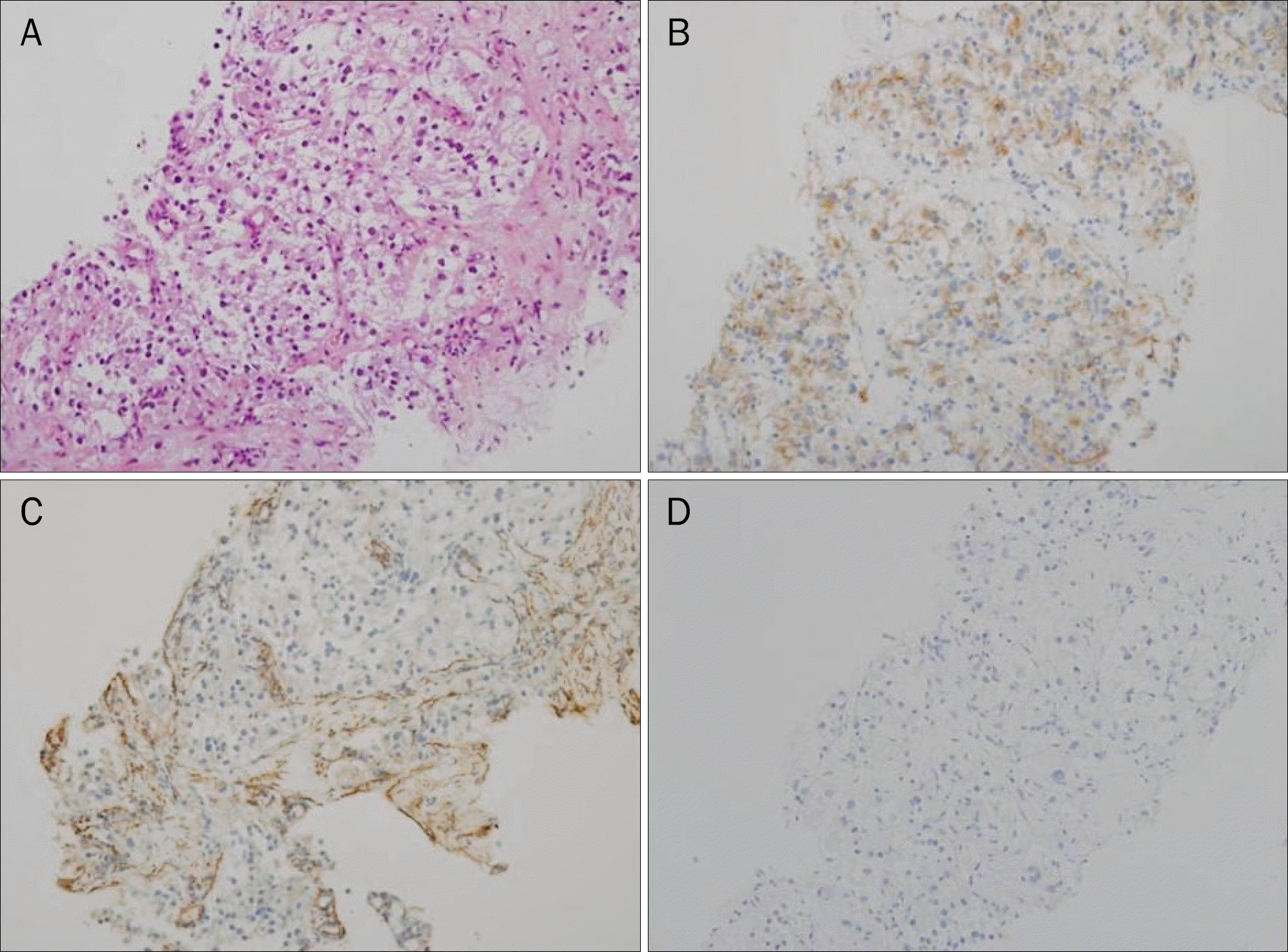Abstract
Perivascular epithelioid cell tumors (PEComas) are unusual mesenchymal neoplasms composed of histologically and immunohistochemically distinct perivascular epithelioid cells (PECs). Although PEComas have the potential to behave in a malignant fashion, malignant PEComas arising from the retroperitoneum are extremely rare. A 68-year-old woman presented with a painful palpable mass in her left upper abdomen. Computed tomography of the abdomen showed a 9 cm sized heterogeneous mass in left para-aortic space and multiple hypervascular nodules in the liver. 18 F-fludeoxyglucose-PET/CT showed multifocal hyper-metabolic lesions in retroperitoneum, liver, and skeletal bones. Percutaneous needle biopsies were done on the retroperitoneal and hepatic mass. Both specimens were positive for human melanoma black-45 (HMB-45) on histological and immunohistochemical staining which was compatible with PEComas. Herein, we report a rare case of retroperitoneal PEComa with multiple metastases involving liver and bone at initial diagnosis that exhibited aggressive behavior and resulted in a devastating prognosis.
Go to : 
References
2. Pea M, Martignoni G, Zamboni G, Bonetti F. Perivascular epithelioid cell. Am J Surg Pathol. 1996; 20:1149–1153.

3. Folpe AL, Kwiatkowski DJ. Perivascular epithelioid cell neoplasms: pathology and pathogenesis. Hum Pathol. 2010; 41:1–15.

4. Folpe AL, Mentzel T, Lehr HA, Fisher C, Balzer BL, Weiss SW. Perivascular epithelioid cell neoplasms of soft tissue and gyne-cologic origin: a clinicopathologic study of 26 cases and review of the literature. Am J Surg Pathol. 2005; 29:1558–1575.
5. Hornick JL, Fletcher CD. Sclerosing PEComa: clinicopathologic analysis of a distinctive variant with a predilection for the retroperitoneum. Am J Surg Pathol. 2008; 32:493–501.

6. Ruco LP, Pilozzi E, Wedard BM, et al. Epithelioid lymphangioleio-myomatosis-like tumour of the uterus in a patient without tuber-ous sclerosis: a lesion mimicking epithelioid leiomyosarcoma. Histopathology. 1998; 33:91–93.

8. Yokoo H, Isoda K, Nakazato Y, et al. Retroperitoneal epithelioid angiomyolipoma leading to fatal outcome. Pathol Int. 2000; 50:649–654.

9. Lau SK, Marchevsky AM, McKenna RJ Jr, Luthringer DJ. Malignant monotypic epithelioid angiomyolipoma of the retroperitoneum. Int J Surg Pathol. 2003; 11:223–228.

10. Gupta C, Malani AK, Gupta V, Singh J, Ammar H. Metastatic retroperitoneal epithelioid angiomyolipoma. J Clin Pathol. 2007; 60:428–431.

11. Lans TE, van Ramshorst GH, Hermans JJ, den Bakker MA, Tran TC, Kazemier G. Perivascular epithelioid cell tumor of the retroperitoneum in a young woman resulting in an abdominal chyloma. J Gastrointest Surg. 2009; 13:389–392.

12. Subbiah V, Trent JC, Kurzrock R. Resistance to mammalian tar-get of rapamycin inhibitor therapy in perivascular epithelioid cell tumors. J Clin Oncol. 2010; 28:e415.

13. de León DC, Pérez-Montiel D, Bandera A, Villegas C, Gonzalez- Conde E, Vilchis JC. Perivascular epithelioid cell tumor of abdominal origin. Ann Diagn Pathol. 2010; 14:173–177.

14. Wagner AJ, Malinowska-Kolodziej I, Morgan JA, et al. Clinical activity of mTOR inhibition with sirolimus in malignant perivascular epithelioid cell tumors: targeting the pathogenic activation of mTORC1 in tumors. J Clin Oncol. 2010; 28:835–840.

15. Wu JH, Zhou JL, Cui Y, Jing QP, Shang L, Zhang JZ. Malignant perivascular epithelioid cell tumor of the retroperitoneum. Int J Clin Exp Pathol. 2013; 6:2251–2256.
16. Scheppach W, Reissmann N, Sprinz T, Schippers E, Schoettker B, Mueller JG. PEComa of the colon resistant to sirolimus but responsive to doxorubicin/ifosfamide. World J Gastroenterol. 2013; 19:1657–1660.

Go to : 
 | Fig. 1.Abdominal enhanced computer tomography shows multiple hypervascular nodules in the liver (A) and 9 cm sized heterogenous enhancing mass in left para-aortic space (B). |
 | Fig. 2.PET/CT scan shows 18 F-fludeoxyglucose hot uptakes in the liver (A) and left para-aortic space mass (B). |
 | Fig. 3.(A) The tumor shows nested epithelioid tumor cells with round nucleus and granular eosinophilic or clear cytoplasm (H&E, ×200). The tumor cells are positive for HMB-45 (B, ×200), but negative for smooth muscle actin (C, ×200) and S-100 (D, ×200). |
Table 1.
Proposed Classification of Perivascular Epithelioid Cell Tumors by Folpe et al.3,4
Table 2.
Summary of Previously Reported Cases of Malignant Retroperitoneal Perivascular Epithelioid Cell Tumors




 PDF
PDF ePub
ePub Citation
Citation Print
Print


 XML Download
XML Download